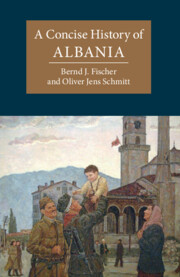Book contents
- A Concise History of Albania
- Cambridge Concise Histories
- A Concise History of Albania
- Copyright page
- Contents
- Illustrations
- Maps
- Preface
- Part I Between Regional Self-Will and Imperial Rule
- Part II State and Nation Construction
- 5 Arnavutluk to Albania: The Triumph of Albanianism, 1912–1924
- 6 Interwar Albania: The Rise of Authoritarianism, 1925–1939
- 7 The Second World War and the Establishment of the Communist Regime, 1939–1944
- 8 Albania’s Stalinist Dictatorship, 1944–1989
- 9 The Struggle to Establish a Democracy since 1989
- Political Systems and the Principal Political Leadership since Independence in 1912
- Suggestions for Further Reading (literature in non-Balkan languages)
- Index
8 - Albania’s Stalinist Dictatorship, 1944–1989
from Part II - State and Nation Construction
Published online by Cambridge University Press: 18 October 2022
- A Concise History of Albania
- Cambridge Concise Histories
- A Concise History of Albania
- Copyright page
- Contents
- Illustrations
- Maps
- Preface
- Part I Between Regional Self-Will and Imperial Rule
- Part II State and Nation Construction
- 5 Arnavutluk to Albania: The Triumph of Albanianism, 1912–1924
- 6 Interwar Albania: The Rise of Authoritarianism, 1925–1939
- 7 The Second World War and the Establishment of the Communist Regime, 1939–1944
- 8 Albania’s Stalinist Dictatorship, 1944–1989
- 9 The Struggle to Establish a Democracy since 1989
- Political Systems and the Principal Political Leadership since Independence in 1912
- Suggestions for Further Reading (literature in non-Balkan languages)
- Index
Summary
Chapter 8 describes the rise of the Stalinist dictatorship under Enver Hoxha from its foundation on the ruins of the prewar Albania, through its construction by the use of Soviet tactics, to its consolidation in the late 1950s. The new Socialist Albania begins the post-war period as a sub-satellite of the Yugoslavs. Barely avoiding absorption as the seventh Yugoslav republic, the state breaks with Tito and becomes a full satellite of the Soviet Union. Albania experiences a fundamental transformation of society and the economy in pursuit of socialism and the "socialist man." The regime follows the Soviet model with collectivization and rapid industrialization but as the Soviets soften following the death of Stalin, Hoxha becomes more extreme turning to China as Albania’s third protector. The Chinese period witnessed the excesses of the ideological and cultural revolution but as China begins to integrate into the world community Albania is left isolated with a deteriorating economy. Hoxha’s successor, Ramiz Alia attempts to preserve the system through generally minor reforms. The chapter concludes with an evaluation of the Hoxha years.
Keywords
- Type
- Chapter
- Information
- A Concise History of Albania , pp. 274 - 322Publisher: Cambridge University PressPrint publication year: 2022

